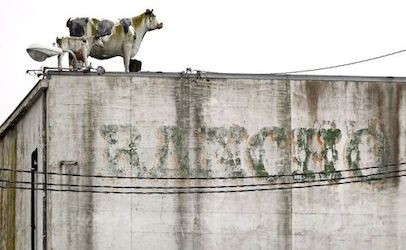
Many people are wondering why 8.7 million pounds of meat processed by Rancho Feeding Corporation in Petaluma,CA,were recalled and the slaughterhouse subsequently closed.
Could it be an inspector shortage?An inspector-veterinarian dispute?Cancerous cow eyes and circumvented inspection requirements?
Theories abound,and we're keeping count.
The union representing U.S.Department of Agriculture meat inspectors is offering one explanation.Last week,Stan Painter,who chairs the National Joint Council of Food Inspection Locals,suggested inspector shortages around the country might have contributed to the problems in Petaluma.
This theory,first advanced last week in The New York Times,appears to have been discredited.The Times itself published a correction that did little to unwind?the confusion over how vacancy or normal turnover rates got tangled up with poultry plant assignments and then projected onto staffing for beef-veal operations in Rancho.
Staffing numbers,however,are not an issue.
"There was no staffing shortage at Rancho Feeding;rather,it appears FSIS inspection procedures were consciously circumvented,"a knowledgeable source told?Food Safety News.
Now,Paul Carney,president of the Western Council of the National Joint Council of Inspection Locals,is advancing a competing theory.The Press Democrat in Petaluma today published a story,sourced to Carney,that says the issues stem from a dispute between a USDA inspector and the now-retired federal veterinarian assigned to the plant over the handling of certain animals,and that FSIS was slow to take the dispute seriously.
Carney's explanation of events at Rancho is at least plausible.He reportedly reviewed the inspector's reports of the events.
While there is no outbreak or illness involved in the Rancho recall and shutdown,there is an ongoing federal investigation involving?USDA's Office of the Inspector General(IG)and the U.S.District Attorney Office that has shut down most sources of government information on the case.
USDA's Food Safety and Inspection Service(FSIS)found the Petaluma slaughterhouse processed"diseased and unsound animals."All beef and veal that Rancho produced in 2013 was recalled.
Theory No.3 involves local Congressmen Jared Huffman(D-San Rafael),and Mike Thompson(D-St.Helena).Huffman says Secretary of Agriculture Tom Vilsack told him that USDA wants to know if the company was involved in"intermittent circumvention of inspection requirements."
And,finally,the San Francisco Chronicle reported today that Rancho was buying cows with eye cancer and separating their heads from the rest of the carcass outside the view of inspectors.
The newspaper reports that inspectors found two cattle heads infected with eye cancer after the original recall of 40,000 pounds of beef in January and the second recall on Feb.8 that took the total to 8.7 million pounds.USDA's use of the word"diseased"to describe the recalled beef may give credence to this latest report.
Before Carney's recent suggestion of possible mistreatment of animals at Rancho,many were drawing comparisons between how USDA is handling this incident?to the 2008 recall of 143 million pounds of beef produced at a Chino,CA,slaughterhouse by the Hallmark/Westland Meat Packing Co.
Hallmark/Westland remains the largest beef recall in U.S.history.It was found to be processing"downer"cows at the same time it was one of the biggest suppliers to the National School Lunch Program.
No outbreak or illnesses were ever connected to that recall either,but USDA quickly shut down Hallmark/Westland and forced the recall because"downer"cows are a risk for Bovine Spongiform Encephalopathy(BSE),or mad cow disease.
In response to some of the theories that have been building,Robert Singleton,one of the two Rancho owners,?told the Press Democrat the company never slaughtered animals without USDA meat inspectors present.





